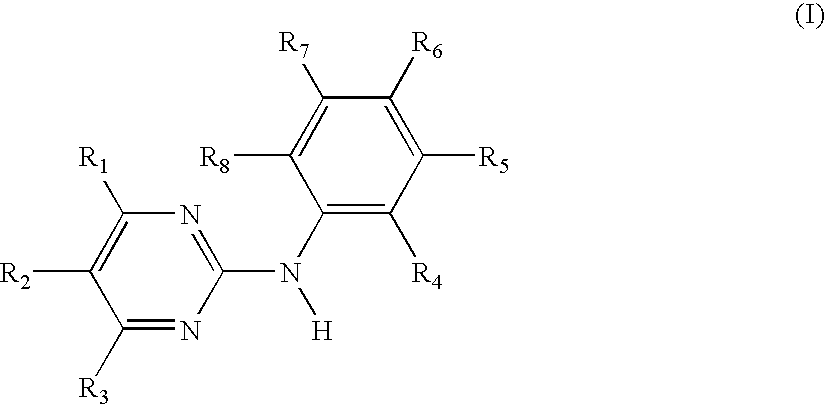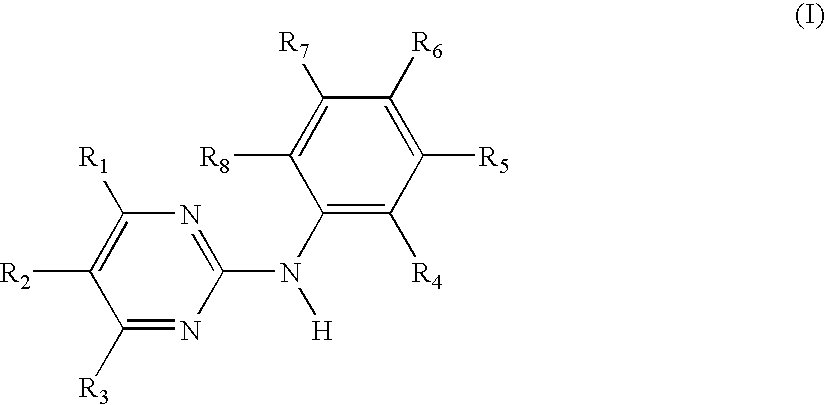Use of N-Phenyl-2-pyrimidineamine Derivativea Against Mast Cell-based Diseases Like Allergic Disorders
a technology of n-phenyl-2 pyrimidine and derivatives, which is applied in the field of new use of n-phenyl-2 pyrimidineamine derivatives, can solve the problems of cutaneous mast cell tumors in dogs, limited options, and eczema-type lesions
- Summary
- Abstract
- Description
- Claims
- Application Information
AI Technical Summary
Problems solved by technology
Method used
Image
Examples
example 2
Methods
[0060]Reagents; Novartis Pharma; Basel, Switzerland provided SALT I for use in these experiments. Fresh 10 mM stock solutions of the inhibitor were made before each experiment by dissolving compound in 1 mL Phosphate-Buffered Saline (PBS; Gibco-BRL),
[0061]Antibodies: A polyclonal rabbit anti-KIT antibody (c-kit Ab-1) was used at a dilution of 1:500(c-kit Ab-1; Oncogene, Cambridge, Mass.). An anthphosphotyrosine antibody (PY20) was used at a dilution of 1:1000 (PY20 Transduction Laboratories; Lexington, Ky.). Peroxidase conjugated goat anti-mouse antibody was used at a dilution of 1:5000) and goat anti-rabbit antibody at a dilution of 1:10,000 (Pierce; Rockford, Ill.).
[0062]Cell lines: BR and C2 canine mastocytoma cells lines were obtained from Dr. George Caughey (University of California at San Francisco, San Francisco, Calif.). Both cell lines were maintained in DM EM supplemented with 2% bovine calf, 1 mM L-glutamine, 12.5 mM HEPES (pH 7.5). 0.25 mg / mi Histidine, 1% Penicil...
example 3
COMPOUND I Inhibits the Constitutively Activated KIT Kinase Associated with Canine Mast Cell Tumors
[0065]To test the efficacy of COMPOUND I in inhibiting the kinase activity of mutant forms of canine KIT we used two cells lines (BR and C2) that express two different constitutively activated KIT isoforms. The KIT mutations in these cell lines are both located in the juxtamembrane domain and are homologous to mutations seen in human Gastrointestinal Stromal Tumors (GISTs) (Lux et al, Am. J. Pathol., Vol. 156, No. 3, pp. 791-785 (2000); Rubin et al., Cancer Res., Vol. 61, No. 22, pp. 8118-8121 (2001)). Lysates prepared from BR or C2 cells were probed with an anti-P-Tyr antibody and KIT receptor activation was assessed by measuring autophosphorylation. As reported previously, KIT autophosphorylation in these cells was observed in the absence of SLF (Ma et al., J. Invest. Dermatol., Vol. 112, No. 2, pp. 186-170 (1999); Ma et al., J. invest. Dermatol., Vol. 114, No. 2, pp. 392-394 (2000))...
example 4
COMPOUND I Inhibits the Proliferation of Cell Lines of Canine Mast Cell Tumors
[0066]To test the biologic effect of inhibiting the kinase activity of a mutant c-kit receptor, we cultured BR or C2 cells for 48-72 hours in the presence of various concentrations of COMPOUND I. At inhibitor concentrations of 0.1-10 μM, proliferation was decreased by 90-95% compared to cells treated with media only. Partial inhibition of proliferation was seen at doses of 0.001-0.01 μM COMPOUND I. The decrease in proliferation seen with doses of 0.01-10 μM inhibitor was statistically significant (p<0.001). Therefore, COMPOUND I inhibits proliferation of BR and C2 cells with the same dose response range as seen for inhibition of receptor autophosphorylation. Morphologic observations of the inhibitor treated calls revealed changes consistent with apoptosis (data not shown).
TABLE 1BR cellsAverages%SD% SDCells0.929100%0.0304473%5 μM0.0839%0.0017320%1 μM0.10511%0.0020%.1 μM 0.10511%0.0020820%.01 μM 0.47952%0....
PUM
 Login to View More
Login to View More Abstract
Description
Claims
Application Information
 Login to View More
Login to View More - R&D
- Intellectual Property
- Life Sciences
- Materials
- Tech Scout
- Unparalleled Data Quality
- Higher Quality Content
- 60% Fewer Hallucinations
Browse by: Latest US Patents, China's latest patents, Technical Efficacy Thesaurus, Application Domain, Technology Topic, Popular Technical Reports.
© 2025 PatSnap. All rights reserved.Legal|Privacy policy|Modern Slavery Act Transparency Statement|Sitemap|About US| Contact US: help@patsnap.com


